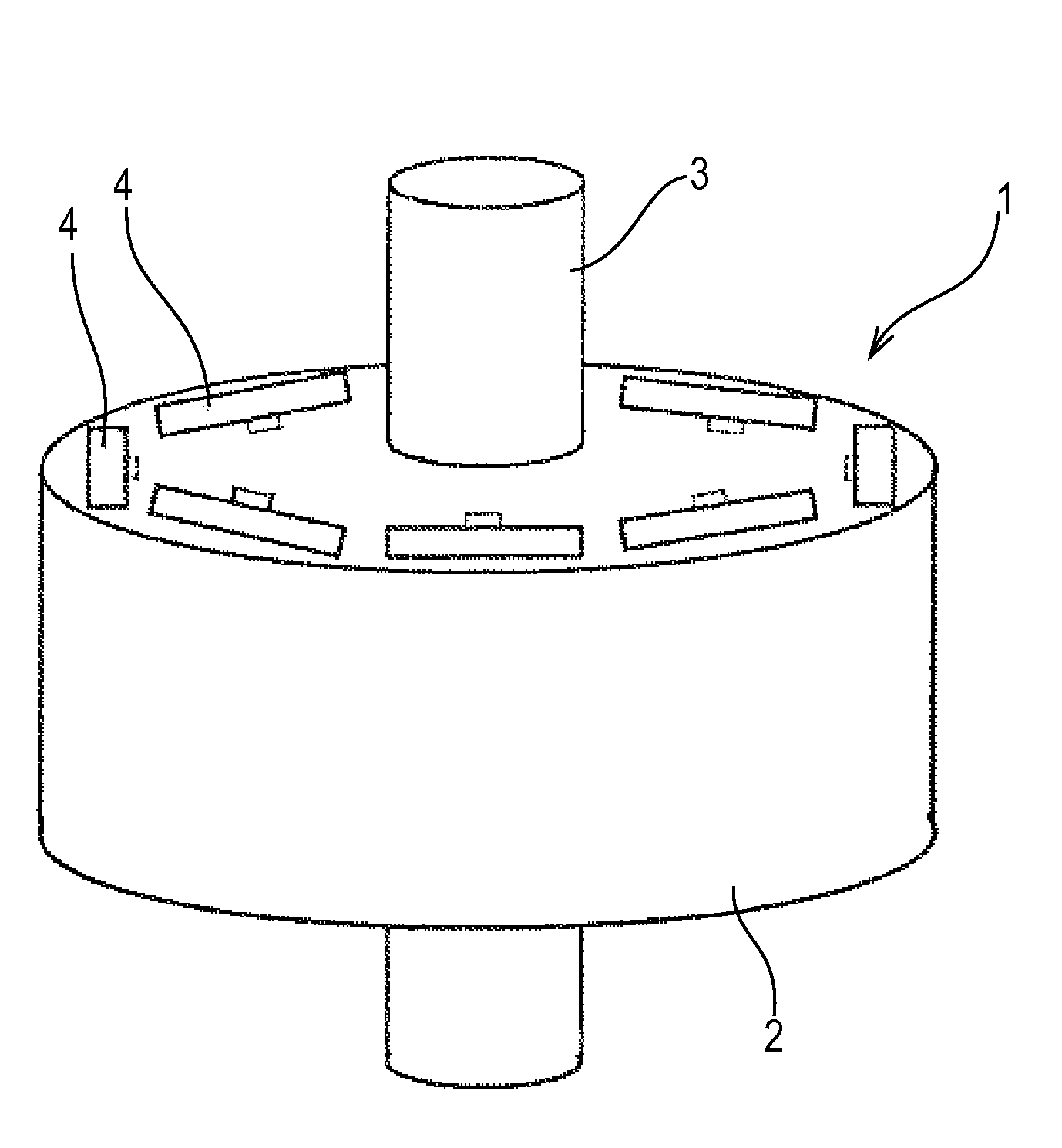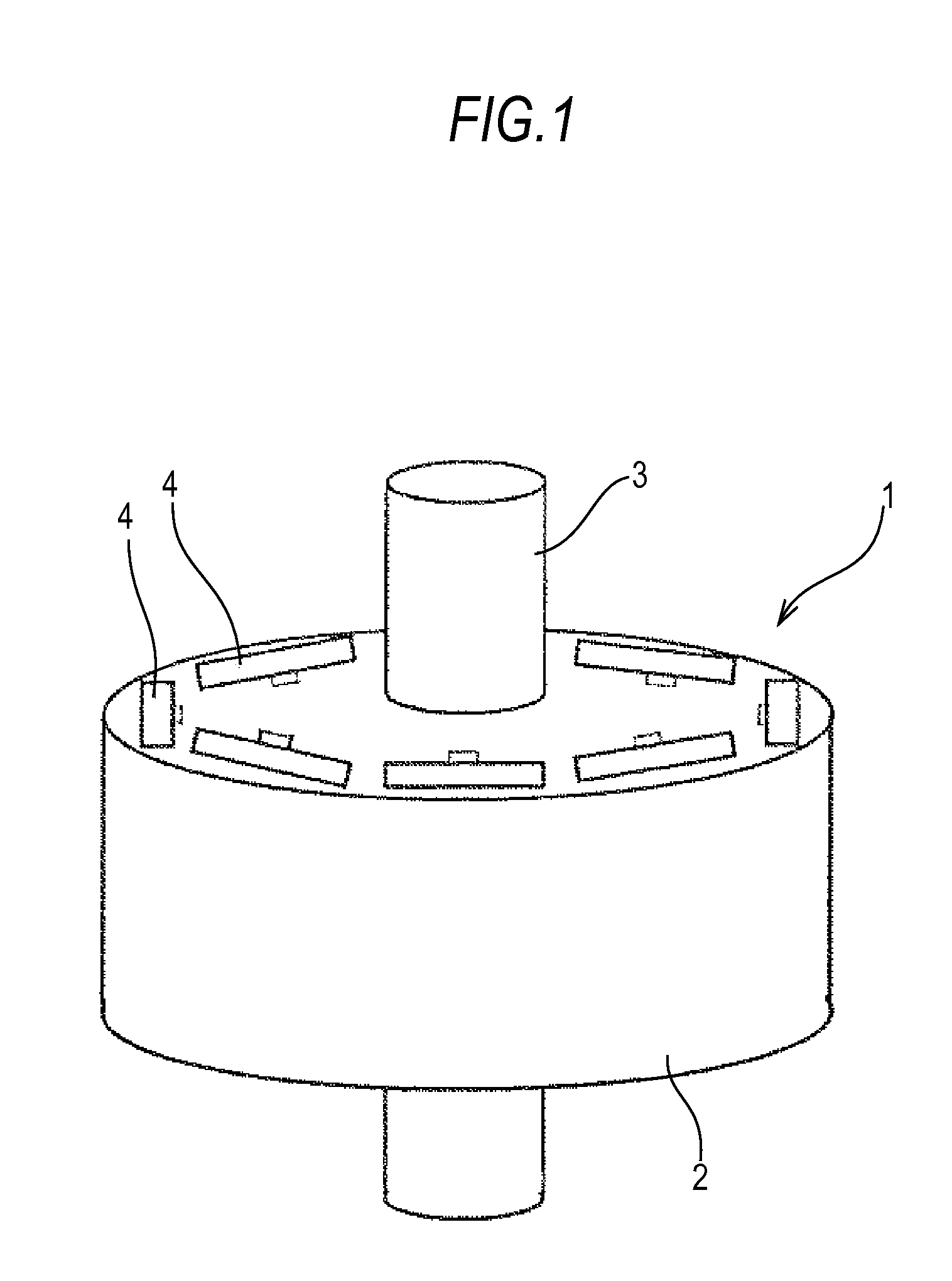Permanent magnet rotor
a permanent magnet and rotor technology, applied in the direction of magnetic circuit rotating parts, dynamo-electric machines, magnetic circuit shape/form/construction, etc., can solve the problems of difficult pressing the rubber into the slot, damage to the magnet structure of patent document 1, etc., to prevent the vibration of the magnet, simple shape, and low cost
- Summary
- Abstract
- Description
- Claims
- Application Information
AI Technical Summary
Benefits of technology
Problems solved by technology
Method used
Image
Examples
first embodiment
[0018]FIG. 1 is a perspective view of a permanent magnet rotor 1 of the invention. The rotor 1 is formed by fixedly fitting a rotor core 2 to a rotation shaft 3. The rotor core 2 is formed by laminating plates of a magnetic material, such as silicon steel plates, punched out by a mold. The rotor core 2 is provided with a plurality of permanent magnet embedment slots (hereinafter, referred to simply as the magnet embedment slots or slots) 4 to embed permanent magnets. The magnet embedment slots 4 are provided parallel to the shaft 3 at equally spaced positions closer to an outer periphery.
[0019]FIG. 2 is a detailed view on a periphery of the magnet embedment slot 4. The magnet embedment slot 4 is formed of a magnet storing portion 4a in a rectangular shape comforting to a shape of a magnet and a buffer and other members storing portion 4b continuing to the magnet storing portion 4a at substantially the center of a long side of the magnet storing portion 4a. The magnet storing portion...
second embodiment
[0024]FIG. 4 through FIG. 6D show a second embodiment of the invention and members in common with FIG. 1 through FIG. 3C are labeled with the same reference numerals. A difference of a permanent magnet rotor of the second embodiment from the counterpart of the first embodiment above is the pushing member. As is shown in FIG. 4, a magnet embedment slot 4 in the permanent magnet rotor of the second embodiment is formed of a magnet storing portion 4a in a rectangular shape comforting to a shape of a permanent magnet 7 and a rectangular buffer and other members storing portion 4c continuing to the magnet storing portion 4a substantially at the center of a long side of the magnet storing portion 4a. The magnet storing portion 4a and the buffer and other members storing portion 4c are formed simultaneously by punching. The buffer and other members storing portion 4c is of a rectangular shape herein. It should be appreciated, however, that the buffer and other members storing portion 4c ma...
third embodiment
[0029]FIG. 7 and FIGS. 8A through 8C show a periphery of a magnet embedment slot 4 in a permanent magnet rotor of a third embodiment. In the first and second embodiments above, the buffer member 8 and the pushing member 9 or 9a are separate parts, and when assembled, the pushing member 9 or 9a is inserted into the buffer and other members storing portion 4c after the buffer member 8 is inserted therein. On the contrary, the third embodiment uses a buffer and pushing member 11 prepared by making a plate-shaped buffer member 8 and a pushing member 9, which is a resin or metal split pin, into one piece with an adhesive 10. The rest of the configuration is the same as the configuration of the first or second embodiment above, and a description is omitted by labeling the common components with the same reference numerals. Referring to FIG. 7, the buffer and the pushing member 11 is formed of the pushing member 9 in the shape of a split pin and the buffer member 8. It should be appreciate...
PUM
 Login to View More
Login to View More Abstract
Description
Claims
Application Information
 Login to View More
Login to View More - R&D
- Intellectual Property
- Life Sciences
- Materials
- Tech Scout
- Unparalleled Data Quality
- Higher Quality Content
- 60% Fewer Hallucinations
Browse by: Latest US Patents, China's latest patents, Technical Efficacy Thesaurus, Application Domain, Technology Topic, Popular Technical Reports.
© 2025 PatSnap. All rights reserved.Legal|Privacy policy|Modern Slavery Act Transparency Statement|Sitemap|About US| Contact US: help@patsnap.com



